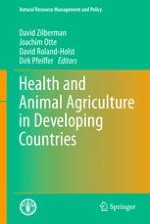2012 | OriginalPaper | Chapter
6. Dynamic Perspectives on the Control of Animal Disease: Merging Epidemiology and Economics
Authors : Richard D. Horan, Christopher A. Wolf, Eli P. Fenichel
Published in: Health and Animal Agriculture in Developing Countries
Publisher: Springer New York
Activate our intelligent search to find suitable subject content or patents.
Select sections of text to find matching patents with Artificial Intelligence. powered by
Select sections of text to find additional relevant content using AI-assisted search. powered by
